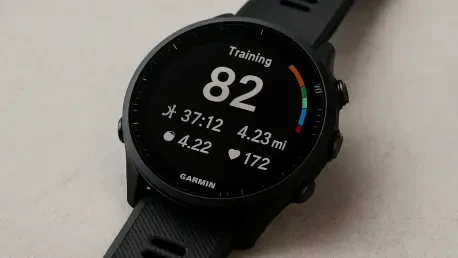I’m thrilled to sit down with Simon Glairy, a renowned expert in fitness technology and wearable devices, who has extensively tested and reviewed some of the most cutting-edge smartwatches on the market. Today, we’re diving into his experience with the Garmin Forerunner 955, a device celebrated for its robust features tailored to athletes and fitness enthusiasts. In our conversation, we’ll explore how this smartwatch stands out in terms of battery performance, training insights, navigation tools, and user-friendly design, as well as Simon’s personal take on its impact on daily routines and athletic performance.
What initially sparked your interest in the Garmin Forerunner 955 as a fitness tracker?
Honestly, I’ve always been fascinated by devices that give me a deeper look into my own data—sleep patterns, stress levels, and especially workout metrics. The Forerunner 955 caught my eye because it promised high-quality data for running, which is my main focus. I wasn’t new to Garmin; I’d used their devices before, but this model stood out with its advanced features like Training Readiness and long battery life. It felt like the perfect upgrade for someone like me who’s obsessed with tracking every detail of my fitness journey.
How has the battery life of the Forerunner 955 influenced your day-to-day activities?
It’s been a game-changer. With up to 15 days in smartwatch mode on the non-solar version I use, I’m charging it far less than I expected—maybe once every 10 to 12 days with regular use. During a recent marathon, I was blown away that it only dropped less than 20% of its charge over hours of continuous GPS tracking. That kind of reliability means I’m not stressing about power during long events or multi-day training sessions, which is a huge relief compared to other devices I’ve used.
Can you share how the Training Readiness score has shaped your approach to workouts?
Absolutely, it’s one of my favorite features. The score combines data on sleep, recovery, heart rate variability, and training load to give me a clear idea of whether I should push hard or ease up. I check it almost daily, especially after tough sessions, and it’s helped me balance intensity with rest. Since using it, I’ve noticed I’m recovering better and avoiding overtraining, which has definitely improved my overall performance. It’s like having a little coach on my wrist guiding my decisions.
What’s your experience been like with the Morning Report feature?
I didn’t think I’d care about it at first, but now it’s a highlight of my morning. Waking up to a quick summary of my sleep score, HRV trends, weather, and a suggested workout sets the tone for my day. It’s like a mini briefing that helps me plan ahead—whether I’m tweaking my training or just mentally preparing for what’s next. It’s made me more intentional about how I start my day, and I find myself looking forward to that snapshot each morning.
How have the navigation and GPS capabilities of the 955 enhanced your running experiences?
The navigation is fantastic, especially with full-color maps and turn-by-turn directions. I’ve programmed new running routes on unfamiliar terrain, and following the map on my wrist has been a lifesaver. There was one time I took a wrong turn during a long run in a new city, and the GPS got me back on track without missing a beat. For someone who’s not great with directions, this feature has boosted my confidence to explore new paths without worrying about getting lost.
What are your thoughts on the dual control system with both touchscreen and buttons?
I love the flexibility of having both. The touchscreen is super responsive for casual use, like checking stats or navigating menus when I’m not active. But mid-run, especially when my hands are sweaty, I stick to the buttons—they’re just more reliable in those conditions. Compared to older watches I’ve used with only buttons, this hybrid setup feels intuitive and makes interacting with the device so much smoother, no matter the situation.
You’ve noted the display isn’t AMOLED but still effective. Can you elaborate on how it performs for you?
Yeah, while it’s not AMOLED, the MIP screen is honestly more than adequate. The brightness and colors hold up really well, even in direct sunlight, which is critical for outdoor runs. I can read my stats clearly without squinting, whether it’s dawn or midday. Sure, a fancier display might look slicker, but for my needs—clear data at a glance during a workout—this screen gets the job done perfectly, and I haven’t found myself wishing for anything more.
Looking ahead, what’s your forecast for the future of fitness trackers like the Forerunner 955 in terms of technology and user impact?
I think we’re heading toward even more personalized and predictive tech in fitness trackers. Devices like the Forerunner 955 are already giving us deep insights with features like Training Readiness, but I expect future iterations to integrate more AI-driven analysis, perhaps predicting injuries before they happen or tailoring training plans in real-time based on subtle body signals. Battery life will likely keep improving, and I wouldn’t be surprised if we see more seamless integration with other health systems, like medical records or nutrition apps. For users, this means fitness trackers will become less of a tool and more of a comprehensive health partner, guiding not just workouts but overall wellness in a really holistic way.









